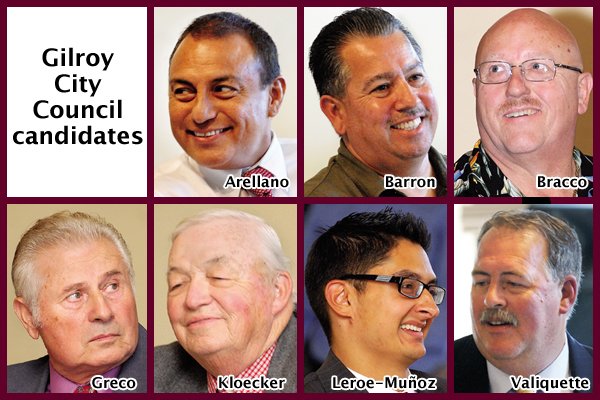Seven candidates running for three City Council seats makes for
a fierce race, but the focus has been on the issues facing the city
rather than dunking each other’s head under dirty political
water.
Gilroy City Council race: Meet the Candidates
Candidates Q
&
amp;A
Seven candidates running for three City Council seats makes for a fierce race, but the focus has been on the issues facing the city rather than dunking each other’s head under dirty political water.
Those already in the Council are more contentious than the candidates, said Susan Jacobsen, 57, who owns a real estate business downtown, “I didn’t get the sense that they were putting daggers in each other’s back. They seem very respectful of each other.”
Two incumbents, two political veterans and three newcomers – all men, ages 30 to 75 – are looking for a seat on the dais.
Ideas on hotbed issues, such as the high-speed rail running through town, range from stopping the 220 mph bullet-train project altogether to facilitating a smooth transition for the train to stop downtown and turn the economy around.
The Santa Clara County registrar has already mailed the ballots to city voters and those who don’t know the candidates are beginning to do their research.
Aside from the high-speed rail, candidates have been questioned on marijuana dispensaries, bringing businesses to Gilroy, stimulating development, outsourcing, and looking into funneling money into the downtown association.
One candidate wants Gilroy to generate its own power.
“I got a plan for the city. It’s all laid out,” said Greco, 72, a now-retired electrical department worker for the city of Santa Clara, who wants Gilroy to take over the operation of Pacific Gas & Electric’s power utilities which could lower costs for businesses and residents.
“I would rent their system. If PG&E operates the distribution, we pay 13 cents an hour. We’ve had little luck in attracting outside employers. You have to entice them. They’ll have more incentive to come if utilities are reduced.”
Greco, who was born and raised here, was the first to put up signs announcing his candidacy in August. He’s soft-spoken, but does not rely on safe generalizations like some of his fellow candidates: His views are black and white.
For example, Greco wants to get rid of Gilroy’s residential growth control ordinance, and unleash development. Also, he’s opposed to contracting for any ongoing city services.
When asked whether he would rather sell the Gilroy Gardens if he were faced with having to cut the city budget, he said he would, though he would be sorry to lose such a great asset.
On the high-speed rail, he said, “I like trains,” he said, “but I’d like them to go slower to be able to see the countryside.”
Leroe-Muñoz, 30, is on the opposite side of the age and high-speed rail spectrum. But, like Greco, he’s prepared to stick to his guns.
The San Benito County Deputy District Attorney is well aware of the heated debates surrounding the bullet train. He has attended City Council meetings and knocked on the door of possible constituents. He arrived at the conclusion that he not only wants the train to run through Gilroy, but he wants it smack in the middle of downtown. Downtown vibrancy and development are among his top priorities – and the high speed rail will spice things up in the downtown, who cares if it isn’t pretty?
For downtown development, he has several plans, one of them is to use Community Development Block Grant funds from the federal Department of Housing and Urban Development as loans for retrofitting downtown’s notorious unreinforced masonry buildings.
According to Susan Jacobsen – who lamented the lack of business people in the candidate mix – Leroe-Muñoz scored high at a recent Rotary Club candidate’s forum. “He’s very articulate and is willing to do his homework,” she said, “not all candidates are.”
Leroe-Muñoz has something in common with incumbent Dion Bracco. Both want to start a Police Activities Youth League in Gilroy, which would offer youth athletic and educational programs in a supervised environment. Leroe-Muñoz has worked with the PAL program in San Benito County and believes it’s a helpful remedy for gang violence.
“The Police Activities League would be able to meet with them in a nonconfrontational setting,” said Leroe-Muñoz.
Incumbent Peter Arellano, a 60-year-old physician, believes in infusing money into the projects of the Department of Parks and Recreation to keep youth busy and out of trouble.
But Bracco, 52, an incumbent who sported a rainbow tie at one forum and a Hawaiian shirt at another, wants to champion a PAL-type program and target the top 10 at-risk youth and those who are already in a gang. Police, school principals and parents would work together to reel them back in or chase them out of town.
Bracco thinks Gilroy’s downtown is perceived as dangerous, but he believes that’s unwarranted. To fix that image, he thinks businesses should step up and do something. “The city can only do so much sprucing it up,” he said at a recent forum sponsored by Leadership Gilroy. “We need a strong downtown association and stores should keep uniform hours.”
He thinks the downtown association should be more inclusive – noting the board is all white while many businesses downtown are owned by Hispanics.
Sprucing up the city center means bringing new businesses in, and all candidates were inevitably questioned on how they would relieve Gilroy’s downtown commerce dry spell.
While Gilroy Gardens Park Operations Manager Russ Valiquette, 50, does not agree the city should fund a downtown association, as some business owners propose, he wants to push to find the perfect formula to lure a large corporation to town. He acknowledges that would require some funding.
“It takes money to make money and, to help us get out of this rut, we need to bring more businesses,” said the Leadership Gilroy alumnus. “I still don’t know what the model is to bring a Safeway corporate office or something down here, but that would probably take money.”
The fiscally-conservative Valiquette stressed city interference would not be good for any business association.
The city, for its part, should take care of its checks and balances as if it were a household: Every penny counts and every loss matters.
Math is second nature to Paul Kloecker, 75, a retired engineer who served on the City Council for 12 years.
“I’m a very detailed person, very concerned with numbers and tremendously interested in all things financial: Budgeting, policy planning,” he said.
He wants to review the city’s calculations regarding impact fees for development, where he said, some “unfeasible stuff” is factored into the calculation since the economic meltdown.
He opposes binding arbitration and believes the city and its unions, such as those representing firefighters and police, should settle contract issues independently.
During Kloecker’s 15-year hiatus – his last term ended in 1995 – he said he would often watch televised City Council meetings like others watch football. During the MediLeaf saga he joked that “he could throw shoes” at the TV screen when he disagreed.
“I really think the council should have been more decisive on the permit for the dispensary because it violated the building permit,” he said, expressing strong support for the city’s efforts to shut down the dispensary.
Art Barron, 47, like Kloecker, strongly opposed the medical marijuana dispensary and supported the city’s lawsuit to shut it down.
Barron is the community organizer of the bunch. Since he arrived in Gilroy 18 years ago, he has participated at the Garlic Festival, served as president of the Gilroy Eigleberry Neighborhood Association, participated in an annual toy gift exchange for underprivileged children, and served on the Leadership Gilroy Board and the Housing Advisory Committee, among others. As a former planning commissioner, he still seeks the advice of the Planning Committee and would probably continue to do so if he was elected.
Arellano, who said jokingly that he often finds out about the problems of the city when he’s medically examining his constituents, thinks balancing the budget is a high priority. Especially with an economic recovery in sight, he warns against loosening up the spending belt.
“We’ve gone through a tremendous turmoil and by balancing the budget, we’ll continue to go through this recovery without spending,” he said. “Whether it’s going to pick up or not, we need to have people who have experience. I’ve been there in the good times and also in the bad times.”
In a recent Leadership Gilroy forum, he pledged to work on the lack of parking downtown by looking into placing parking spaces behind the businesses which line Monterey Street.
But while Arellano talks to his patients and Barron asks the Planning Commission for advice, Dion Bracco seeks counsel higher up.
“I pray a lot and I ask God to help me to lead this city,” he said at the Leadership Gilroy forum. “But the buck stops here.”
Gilroy City Council race: Meet the Candidates
Candidates Q&A














